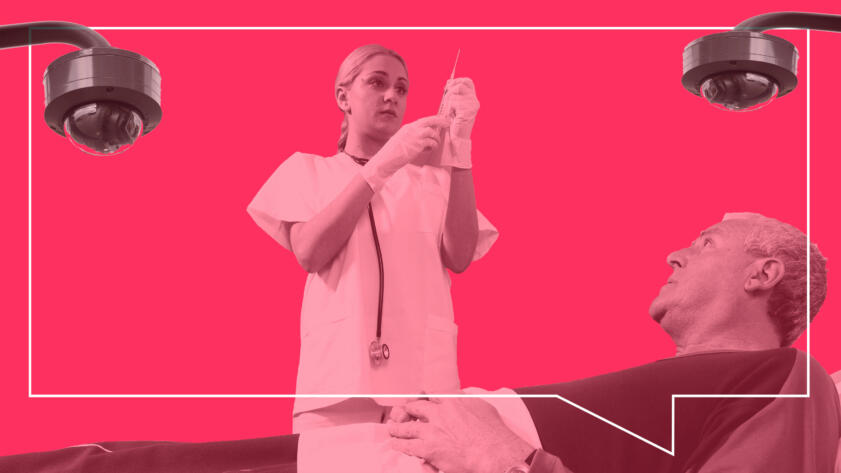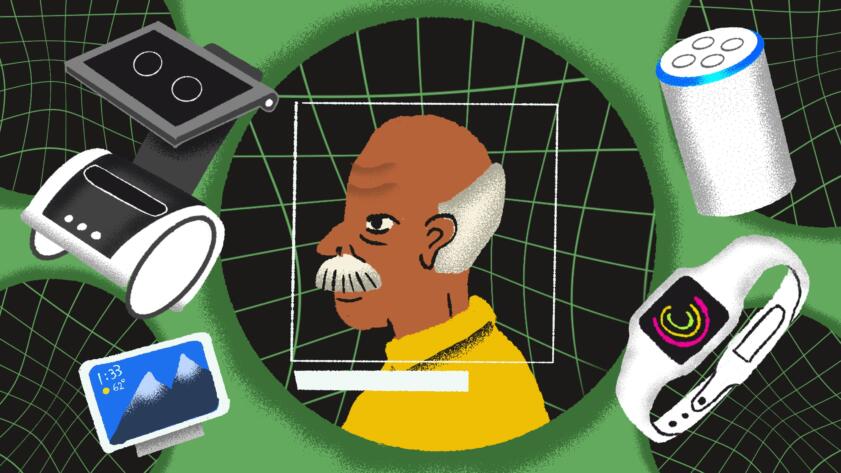In the summer of 2020, as the COVID-19 pandemic locked many inside their homes, seniors quickly became some of the most isolated. Especially susceptible to the virus, and still without a vaccine, older adults found themselves unable to visit with loved ones they relied on.
Some tech companies stepped in with an offer to help.
In May of that year, Google announced that it would give away 1,000 of its Nest Hub Max voice assistants to retirement communities in Washington state. The same month as Google’s announcement, Amazon announced that it was donating $5 million in smart speakers to health care workers, students, and retirement communities. The donation provided Echo Dot voice assistants for senior homes in Washington state and California “to help residents become more independent, while staying informed, engaged and connected with friends, family and caregivers,” the company said in a blog post.

The Breakdown
Should Families’ Surveillance Cameras Be Allowed in Nursing Homes?
Several states have passed laws allowing the practice—but not without controversy
And just this week, Amazon announced plans to bring Alexa to even more senior living communities. The program, part of its “Alexa Smart Properties” initiative, will allow community operators to install Alexa devices and make announcements to residents through them, as well as to “streamline activities like check-ins, field requests for maintenance, and administrative tasks—enabling associates to save time and increase productivity,” according to the company’s announcement.
Those aren’t the only initiatives Big Tech is exploring for seniors. In the past year, several industry behemoths—including Google, Apple, and Amazon—have announced products and services geared toward helping older adults, once the realm of more niche companies.
For those larger companies, there’s an obvious market incentive. Seniors, in general, adopt tech at a low rate, but that rate has been accelerating in recent years. Voice assistants, especially, have made access easier for less-tech-savvy consumers.
“Voice technology availability, ease of access, and who has all the money—that has created interest in this market,” said Laurie Orlov, who heads the analyst site Aging and Health Technology Watch and noted the trend in a blog post earlier this month.
The draw for seniors is clear. Devices like voice assistants and wearables are simple to use and can give some peace of mind to family members, who can chat over video calls and even digitally monitor loved ones’ behavior. Older adults can also more easily connect to emergency services in case of an accident.
But those innovations have also sparked some concerns among privacy and health care advocates, who wonder about the cost and pitfalls of remotely monitoring loved ones. Some of the core worries: Who’s listening in on these products? Are seniors giving proper consent to being monitored? And what happens to caregiving in a more automated future?
What’s the Pitch from Tech Companies?
With panic about older loved ones spreading in the past year, tech companies have been promoting their devices as at least a partial solution, releasing products for monitoring safety and facilitating communication with older adults.
Apple, for example, announced in 2018 that its Apple Watch would use motion detection to learn when a person wearing the watch falls. While it could be helpful to anyone with concerns, it was clearly targeted: The service is turned on by default for anyone over 55 years old.
This year, the company went even further. Included in its latest iPhone operating system, iOS 15, are algorithms for determining the steadiness of a person’s gait and potential for a fall in the future. The company also released an update for its AirPods called Conversation Boost, which can be used to help the hard of hearing by increasing the volume of a conversation.
Last month, Amazon announced plans to offer a robot dog called Astro.
Other companies, like Google and Amazon, are hitching their plans for elder care to voice assistants. When Google announced its partnership to send Nest Hub Max devices to senior homes, it went beyond just giving away the hardware—the company said it also simplified the software to make it easier for seniors to use.
Last year, Amazon announced a service for its Alexa device line called Care Hub. The service lets caregivers remotely see how an Alexa device is being used, or even sends them an alert if the person they’re looking after doesn’t use their device by a certain time.
The company expanded on the service earlier this year, launching a monthly $19.99 subscription service called Alexa Together, which includes an emergency response call service that can be triggered if a wearable device detects a fall or by the phrase, “Alexa, call for help.”
And the companies seem far from done with services for the elderly. Last month, Amazon announced plans to offer a robot dog called Astro. The robot, equipped with a screen, microphone, and camera, is designed to wheel around a person’s home and respond to commands. In its announcement, Amazon said it imagined the robot being placed in the homes of seniors, giving them reminders during the day and reporting back to family members about their well-being through integration with Alexa Together.
Why Are Tech Companies Interested?
In short, companies are following the money, Orlov said. There’s a relatively untapped market in older adults, and one with command of more dollars than younger people.
Money talks.
Laurie Orlov, Aging and Health Technology Watch
“That’s why,” she said. “Money talks.”
Smaller tech companies have been carving out niche products directly targeting the elderly for some time. But only relatively recently have bigger players shown an interest in the older market.
In her blog post, Orlov pointed out that just a decade ago, the tech industry seemed unconcerned with seniors’ needs. But as the baby boomer population ages, Orlov points out, more of them are looking for ways to stay safe and healthy, while loved ones are searching for ways to watch over them. The pandemic, especially, exposed just how great that need was.
“It was a major embarrassment, really, the lack of connectivity of older people during the pandemic and especially during the time they were supposed to register to get a vaccine,” Orlov told The Markup.
Clara Berridge, a professor at the University of Washington who researches older adults and technology, said there’s another reason why the devices have become so popular. Many people want to stay in their homes as they age, but because of a dire lack of home-care infrastructure in the United States, people are sometimes turning to the only options they can find and afford—consumer tracking devices. “It’s not necessarily comparable service,” Berridge said, “but it’s an affordable option.”
People are mostly on their own to figure out elder care.
Clara Berridge, University of Washington
“We have a very fragmented long-term care system in this country, if you can even call it a system,” she said. “So people are mostly on their own to figure out elder care.”
It’s not just families but also care facilities themselves. Even well before COVID-19, businesses, nonprofits, and retirement communities had been experimenting with providing voice assistants to care home residents. That trend has since accelerated. “I think the turn to institutions is intensified with COVID and concerns around what’s going on in facilities,” Berridge said.
What Are the Concerns?
While devices can provide a sense of connection, some privacy advocates worry about what sorts of data is being collected through those devices—especially since few consumers in general will wade through a complex privacy policy or tinker with settings, and even fewer seniors are likely to do so.
“I think you’re dealing with a population and situation where people are not necessarily even going to exercise the limited control they’re given over how data is collected,” said Hayley Tsukayama, a legislative activist for the Electronic Frontier Foundation.
I think you’re dealing with a population … where people are not necessarily even going to exercise the limited control they’re given over how data is collected.
Hayley Tsukayama, Electronic Frontier Foundation
Concerns about where voice assistant data is traveling aren’t new, but having someone close, like a relative, monitoring behavior, brings its own concerns. It’s not always clear, for one, that seniors are consenting to monitoring.
Amazon’s Alexa Together service requires an opt-in from both the owner of the Alexa device doing the monitoring and the mobile app it is transmitting data to. But as some observers pointed out last year, it seems simple for someone to “opt in” for someone by setting up an account for them and signing up for the service.
Berridge points out that even a caretaker acting with good intentions can, through “benevolent coercion,” subtly pressure an older loved one into using a device they might not be comfortable with. “A caregiver tends to have quite a bit of power over somebody,” she said.
If a loved one is suffering from a condition like dementia, that could change the ethical calculus too, and there may not be a tidy answer to whether that person is consenting to family monitoring, Tsukayama said.
“How do you weigh, as the child of someone, where you think their mind is and their overall ability to understand a situation and protect themselves in a situation, and how they feel about being watched?” she said.
Amazon, for its part, says its care app masks some types of data. A remote watcher would only be able to see that a loved one was using Alexa for “entertainment,” for example, but not see whether a song or podcast was played. But it’s still “really fine-grained” data, Tsukayama said.
Whether in homes or care facilities, Berridge said, there’s also a risk that people will choose to rely on cheap surveillance devices over human labor. There’s already a woefully insufficient number of care workers in the country, she said, and for some operators, placing an Amazon Echo in every room may look like a savvy solution to understaffing. “The conditions are ripe for that, and they have been for a long time,” she said.
Tech companies have good reason to care about what seniors think about privacy. An AARP survey published this year found that, for people over 50, privacy was one of the biggest barriers to adopting new technology, with about 34 percent of people surveyed citing it as a concern.
Apple didn’t respond to a request for comment. A Google spokesperson referred back to the company’s initial announcement of its care facility partnership, which notes the devices were provided “in a way that preserves privacy for the residents, as the devices are managed on Nest’s fleet management system and run in a ‘signed out’ mode, meaning no audio is stored and all activity is anonymous.”
Beatrice Geoffrin, director of Amazon Alexa, said in an emailed statement to The Markup that “privacy is foundational” to its products, including Astro and Alexa Together.
“Astro is built with multiple layers of privacy to provide customers with transparency and control, and we designed Alexa Together to give both the care recipient and caregiver peace of mind, without compromising privacy,” the statement said. “In order to even use Alexa Together, the care recipient has to first approve the connection with their caregiver, and can also end that connection at any time.”
The use of devices for elder care seems likely to expand, even if the pandemic is brought under control. Berridge points out that it’s an example of “disaster surveillance”—installing surveillance devices during an emergency, only for the tools to stick around well after that emergency subsides.
“I don’t think that they’re going to go away, and I think it’s going to enable the scope of what families are doing and what facilities are doing with the tech,” Berridge said. “More surveillance of the workers and more surveillance of the residents.”
Correction
An earlier version of this story said Amazon’s care app could alert a remote watcher when a loved one listened to music. It only alerts observers to “entertainment” generally.





